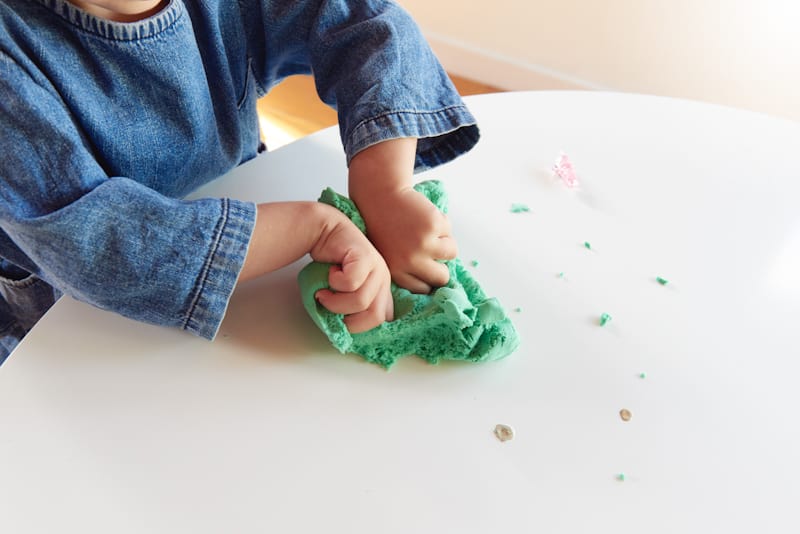
An Argument For Not Making Your Kids Share
Written by Katie Hintz-Zambrano
Photography by Ari Serrano, photographed by Maria Del Rio
In the preschool years and prior, the topic of sharing is a hot one. Just walk into any playground in America and a tussle over a toy—desired by more than one child at the same time—is sure to ensue. How this conflict is handled by parents, however, can go a variety of different ways. For many parents, forcing their child to give up his toy to another kid seems to be the right thing to do. But, according to Heather Shumaker, a mother of two and author of It’s OK Not To Share…And Other Renegade Rules For Raising Competent And Compassionate Kids, there’s a better way to go about this.
Shumaker, a long-time advocate of free, unstructured play, calls her preferred method “child-directed turn-taking.” Below, she explains how it works.
Why Forced Sharing Backfires: Shumaker believes that parents who force their children to share have good intentions. “I think it stems from a deep-rooted desire to promote generosity and help our kids be kind and liked by other people,” she says. “Everybody wants a good, open-hearted child who shares. That’s a huge goal among any family in any society. But the way we go about trying to achieve it often backfires. For a child to learn about kindness and how good it feels to share, they have to learn it on their own terms and it has to come from inside. As parents we can guide that, but if we force children to share, those children often feel terrible about sharing the way they understand it, which means something is going to be taken out of their hands right now.”
What Child-Directed Turn-Taking Looks Like: In essence, child-directed turn-taking is “about waiting until a child is all done with a toy,” says Shumaker. It’s about letting a child fully process what he or she is doing and become engrossed in it, without interruption. “When a child is engaged in imaginative play or her own exploration of the world, that’s the highest form of learning that she can be doing at that moment, and she’s doing it. So, interrupting her is not only disrespectful, it can interrupt learning,” explains Shumaker. Once the child is fully done with her toy or activity—be it 3 minutes or 3 hours, the time should be internally imposed by the child, not an adult or timer—a parent can then remind the child that another kid is waiting for the object, and let the child give it up on his own accord. Of course, there might be exceptions, like nap time or meal time, when interrupting a child is essential.
Why It Benefits The Child With The Toy: Just like an adult would be incensed if constantly forced to give up an object or activity they are currently engrossed in (a book, a movie, work, etc.), children are no different and should be treated with that same respect. Implementing child-directed turn-taking gives a child a sense of autonomy and, as previously mentioned, allows them to learn at the highest level through uninterrupted play, which has incredible cognitive benefits. A child who understands and trusts that an object won’t be forcefully taken away from him, can then express true generosity once he is fully done with an object and is reminded that another child is waiting for it. “Then there’s this moment of almost revelation from the child— ‘Oh, I’m done and I can give it to Jimmy now and it feels good to do that.’ You can see their whole body just electrifying with a rush of good feelings,” says Shumaker. “Teaching that inner generosity and helping a child develop it in the stages of moral development is a wonderful thing.” Not to mention, teaching your child to stand up for himself. “Children can do it with their arms or body posture when they are little. But when children have the language skills to be be able to say, ‘I’m not done yet, you can have it when I’m done,’ that is a life skill we overlook. It takes a lot of courage and practice. The child who is saying ‘no’ is saying so respectfully and setting a reasonable boundary. And that’s a skill we can’t have too much of. It gets into bullying and so many other things later on. We need to help our kids realize that it’s okay to set a limit on a peer and you don’t even need a grown-up once you’re used to it. You can just do it directly.”
Why It Benefits The Waiting Child: “I think we’re so busy rushing kids into being nice and kind that we overlook other life skills, like dealing with anger and frustration and delayed gratification,” says Shumaker. “To express a wish—’Gosh, I wish I had that truck right now’—but have to wait before you get it and feel all of those tough emotions, that’s a lesson even some adults need help with. Practicing the habits of delayed gratification is a much more important value to instill in our children than instant demanding and getting what you want.” She adds that children who are forced to share learn to manipulate adults very easily, by understanding that invoking the word ‘share’ (‘Sonny’s not sharing!’) means instant gratification “as adults swoop in and the child gets what he wants right now. It’s almost like teaching kids to take advantage of someone else and manipulate people, rather than promoting kindness and generosity.”
Playdates, Playgrounds, And Public Spaces: Before you go into a situation where your child will be challenged to share, prep your kid. “If a child brings something to preschool or the playground, or some public space, they need to be aware that other kids may be interested in the object. And if they put it down, no one will know that it’s theirs,” says Shumaker. “But someone will know if they put it in their cubby or on their hook or give it to their dad to hold. So, if the child cares about the object, they should put it with a safe person or safe place. The other kids will learn that if it’s in someone’s cubby, then that means they can’t touch that. They can only touch things in their own cubby.” Likewise with playdates. If another child is coming into your child’s space, prep your child beforehand, stashing any items that they would be uncomfortable sharing in a special area, and vetting toys that your child deems on-limits to all in a common area. Sometimes, instead of being an object your child wants to claim, it’s a space—like the area at the top of a public slide. Shumaker suggests explaining to your child beforehand that in some areas, like parks, it’s important to take “fast turns” because lots of children will be coming through that space. Alternatively, you can try to carve out a private corner for them within a public space that feels like something they can completely possess.
The Challenges: A child who is used to being forced to share might take an extra-long turn, well past their interest level, just to test their parent, says Shumaker. When transitioning to child-directed turn-taking, expect your child to test you until they trust you. Once the child realizes that you’re not going to force her to give up the toy before she’s done, she will start to take shorter and shorter turns with her toy. “Over time, children loosen up and they get more used to a give-and-take, mutually beneficial society,” says Shumaker. “But if they haven’t had a chance to experience ownership, they’re more likely to hog something.” Also to note: If your child’s school has a different philosophy/method for sharing than you do, stick to your course. “A child will encounter a lot of different viewpoints, and they should have flexibility,” says Shumaker. “Just explain that the school and other places do sharing in a different way. And you have your way at your home.”
For more articles on themes like this, check out Mother’s pieces on Play-Based Parenting, Play-Based Education, Teaching Empathy To Children, and How “Reframing” Results In Happier Parents (And Kids). For more on Shumaker’s philosophy on sharing and more, check out It’s OK Not To Share…And Other Renegade Rules For Raising Competent And Compassionate Kids.
Share this story



